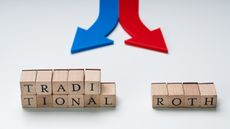Retirement Plans for the Entrepreneur
From Simple IRAs and Solo 401(k)s to SEP IRAs, small businesses have many retirement savings options to choose from. Here are the basics to get started.


The entrepreneurial spirit lies at the heart of the American dream. The path of the small-business owner is noble yet risky, and some entrepreneurs may feel out of their depth when it comes to managing both their business and their personal financial needs. My experience with successful entrepreneurs is they are rightfully intent on building their business in the near-term but forget the importance of rigor and discipline in taking the long view — that is, building their retirement nest egg.
If their business is the type that can be sold years down the road to provide a windfall, they might come out the other side with a comfortable retirement fund. But some businesses are the person himself or herself, such as consultants and Realtors, and while they can be wildly successful during their career, they don’t have anything to “sell” at their retirement. Regardless of the type of business, however, anyone who is self-employed must be deliberate in planning for their retirement, and the sooner they begin that journey, the better off they will be.
Thankfully, the tax code provides powerful tools for self-employed individuals to help them start and grow their nest egg, most with pretax dollars. There are, of course, the workhorse traditional and Roth IRAs, available to both the self-employed and wage earners alike. But their benefits should not be overlooked. The traditional IRA allows contributions of up to $6,000/year ($7,000/year if age 50+) of pretax dollars, and it grows tax-deferred. The Roth IRA allows the same contribution levels after-tax. It gives no immediate tax break, but it grows tax-free. There are also potential income limits that come into play with IRAs — something a small-business owner should consult with a tax and/or financial adviser on.

Sign up for Kiplinger’s Free E-Newsletters
Profit and prosper with the best of expert advice on investing, taxes, retirement, personal finance and more - straight to your e-mail.
Profit and prosper with the best of expert advice - straight to your e-mail.
But those are not the only options available to the self-employed. There are several others, including:
If your business has employees:
401(k). The staple of the corporate world, the 401(k) is also available to small employers. These plans offer high contribution limits — $19,000/year for employee contributions ($25,000/year if age 50+) and up to $56,000/year ($62,000/year if age 50+) when both employee and employer contributions are counted. It offers flexible design, participant loans, pretax and Roth options, and a variety of other features to help both the business owner and their employees achieve their financial goals. If the plan is properly administered, a small-business owner can put away on a pretax basis as much as $62,000/year, depending on their age.
These plans are complex, however, so business owners will want to seek appropriate professional advice to ensure they are being administered appropriately. Employers also need to be cognizant of nondiscrimination testing — that is, the plan cannot favor them or other highly compensated employees — and ensure they’re meeting all federal compliance requirements.
Simple IRA. This type of plan has lower costs than a 401(k) and is easier to administer. The employer contributes 1% to 3% of compensation to the employee’s plan, and the employee can add their own pretax contribution, up to $13,000 ($16,000 if over 50). This plan allows greater contributions than the basic traditional IRA, but clearly not as much as the 401(k). The trade-off is clear: The Simple IRA provides greater contributions than a traditional or Roth IRA, but less than the 401(k). It is a good “middle-of-the road” solution.
If your business has no employees:
Solo 401(k). This plan takes all the attributes of a large corporate 401(k) and applies it to just the small-business owner. Since it is just the self-employed individual in the plan, there are no concerns about nondiscrimination testing. However, the employer/employee contribution limits still apply ($56,000/year, $62,000/year if over 50). For the self-employed individual in a position to sock away a lot of income to bolster their retirement nest egg, this is a clear winner. It also has loan provisions.
The potential downside to this type of plan is that there are start-up and ongoing recordkeeping fees, which vary from custodian to custodian. Reasonable expectations would be start-up fees of $500 to $2,000, and ongoing record keeping fees of $750 to $2,000/year.
SEP IRA. The SEP IRA has low plan costs and simpler administration than a solo 401(k), but a different method of calculating annual contribution limits. The business owner can set aside the lesser of 25% of their compensation or $56,000. So, for example, a self-employed Realtor who makes $200,000 in a year could put up to $50,000 of money into the pretax SEP IRA. Unlike other types of retirement accounts, SEP IRAs do not have any catch-up provisions.
The key takeaway for any small-business owner/self-employed individual reading this is that they have options, and in many ways, more powerful ways to save for retirement than the average W2 wage-earner. But this is also one area where an entrepreneur shouldn’t go it alone — they need to spend some time getting smart and consulting with a financial adviser to ensure they’re setting themselves (and, if they have them, their employees) up for long-term comfort and stability.
The opinions expressed those of the author and do not necessarily represent the opinions of CUNA Brokerage Services, Inc. or its management. This article is provided for educational purposes only and should not be relied upon as investment advice.
*Note: Representative is neither a tax adviser nor attorney. For information regarding your specific tax situation, please consult a tax professional. For legal questions, please consult your attorney.
CUNA Mutual Group is the marketing name for CUNA Mutual Holding Company, a mutual insurance holding company, its subsidiaries and affiliates. Corporate headquarters are in Madison, Wis. Insurance and annuity products are issued by CMFG Life Insurance Company and MEMBERS Life Insurance Company, 2000 Heritage Way, Waverly, IA. 50677. Variable Products are underwritten and distributed by CUNA Brokerage Services, Inc., member FINRA/SIPC, a registered broker/dealer and investment adviser.
401K-2527672.1-0519-0621 ©2019 CUNA Mutual Group
Get Kiplinger Today newsletter — free
Profit and prosper with the best of Kiplinger's advice on investing, taxes, retirement, personal finance and much more. Delivered daily. Enter your email in the box and click Sign Me Up.

Jamie Letcher is a Financial Adviser with LPL Financial, located at Summit Credit Union in Madison, Wis. Summit Credit Union is a $5 billion CU serving 176,000 members. Letcher helps members work toward achieving their financial goals and through a process that begins with a “get-to-know-you” meeting and ends with a collaborative plan, complete with action steps. He is a member of FINRA/SIPC, a registered broker-dealer and investment adviser.
-
 Caregiving Is a Stealth Retirement Expense for Women: I Should Know
Caregiving Is a Stealth Retirement Expense for Women: I Should KnowEldercare takes a toll on everyone, but women's careers tend to suffer more — with dire consequences over the long term.
By MP Dunleavey Published
-
 Listed: 3 Homes for Retiring in Portland, Maine
Listed: 3 Homes for Retiring in Portland, MaineThree real estate listings in Portland, Maine.
By Alexandra Svokos Published
-
 The Golden Window: A Top Tax Strategy for the Right Retirees
The Golden Window: A Top Tax Strategy for the Right RetireesMaximize your retirement savings and minimize your tax burdens by taking advantage of the strategic 'Golden Window' before Social Security and RMDs begin.
By Tony Kure, CFP® Published
-
 Roth or Traditional? Seven Considerations for High Earners
Roth or Traditional? Seven Considerations for High EarnersRetirement savings and taxes are a minefield — and the higher your income, the more complicated the options. Use these tips to find your way forward.
By Tim Kingsbury, CFP® Published
-
 The Social Security Fairness Act: Good News for Retirees?
The Social Security Fairness Act: Good News for Retirees?Millions will be affected by new rules that boost Social Security benefits. But if you qualify, there may be knock-on effects on your retirement cash flow.
By Evan T. Beach, CFP®, AWMA® Published
-
 Want to Hire a Financial Planning Firm? Five Questions to Ask
Want to Hire a Financial Planning Firm? Five Questions to AskThe key to finding a financial planner who will do great work for you and your family is knowing what to look for during your search.
By Joe F. Schmitz Jr., CFP®, ChFC® Published
-
 A Little-Known Tax Buster for Rich Retirees: Zero-Coupon DST
A Little-Known Tax Buster for Rich Retirees: Zero-Coupon DSTMaybe you've heard of using Delaware statutory trusts to defer taxes on real estate investments, but zero-coupon DSTs take those benefits a step further.
By Derek A. Miser, Investment Adviser Published
-
 Once You Hit 55, Is the Stock Market Still Your Best Bet?
Once You Hit 55, Is the Stock Market Still Your Best Bet?If you're investing heavily in the twists and turns of the stock market in your 50s or 60s, you may be risking too much.
By Barry H. Spencer, Registered Investment Adviser Published
-
 How Confident Are You in Your Retirement Plan? Find Out With This Quiz
How Confident Are You in Your Retirement Plan? Find Out With This QuizOn a scale of 1 to 10, how confident are you in your retirement plan? This quick quiz will help you find out if it's on track, or whether it needs more work.
By Sean P. Lee, MSFS Published
-
 Scared About Climate Change? Change the Way You Invest
Scared About Climate Change? Change the Way You InvestClimate change is hitting the U.S. hard, and while positive action from the White House may now be unlikely, individuals can use their wallets to hit back.
By Peter Krull, CSRIC® Published